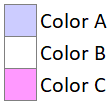
While most mosaic crochet patterns use two colors, some patterns are set up for three. You may also wish to add a third color to one of your own projects: this is entirely doable once you understand how three color mosaic crochet works!
Working with more than one color in a single row in mosaic crochet is very similar to tapestry crochet. The biggest difference is that in order for the colors to line up properly, you need to begin the color change the row before the color is meant to show up.
Click here to view the left-handed version of this tutorial
For patterns on this site, a chart with three colors will designate a Color C:

The chart will also have a row of numbers on the right and left sides showing the total count of stitches in each color:

In this example, you would work 15 stitches in Color A, one stitch in Color C, then 15 stitches in Color A.
Make sure you’re following this guideline for changing colors, NOT following where the colors are in the chart! The chart only shows a preview of what the image will look like, it does not accurately show when to add those colors.
Attaching Color C
When you reach the first row with a color change marked, you’ll want to attach Color C at the start of the row.
If you’re working a flat project with border stitches, work the sc of your border stitch around Color C at the start of the row. Do the same with the finishing border stitch and cut both yarns at the end.
If you’re working in the round, when hooking your next color hook a loop of Color C at the same time. Then chain 1 with the next color only and begin the next row.

Carrying Color C
Carry Color C across the row with you by working any sc stitches over it.
For dc and special stitches you can leave Color C loose behind them, however when there are a lot of these stitches in a row this can lead to an undesirable amount of loose yarn on the back of your work. I recommend carrying the yarn through these stitches whenever there are more than two of them in a row.
To do this, bring Color C forward over the next stitch.

Yarn over, and insert the hook into the stitch and under Color C.

Yarn over with your working yarn and pull up a loop under Color C. You should now have three loops on your hook with Color C passing through the unfinished stitch.

Complete the dc as usual. Color C should be passing through the post of your stitch.

I recommend carrying yarn this way every 2-3 stitches. If you carry it every stitch using this method you run the risk of Color C being visible between the stitches.


If you’re working in the round, when you reach the end of the round and switch to the next color make sure to carry Color C up the seam as well so it’s available the next time you need it. When you hook the next color, hook Color C along with it and pull it through, then chain 1 with the next color only. Do this every row until you’ve finished all rows that use Color C.
Changing Colors & Working With Special Stitches
When you reach a color change in the chart, work the last stitch of the current color up to the final step, then pick up the new color and finish the stitch with it on your hook.


In rows with special stitches it can be difficult to count the stitches. If you’re unsure where the color change belongs, try counting the squares in the graph instead of the stitches worked.

In this row the DC Decrease stitch is split between two colors. The first part of that stitch (the sc) counts as the 10th stitch worked in Color A. The second part of the stitch (two dc worked together) is the first stitch worked in Color C.
Work the sc until there are two loops on your hook. Pick up Color C and finish the sc, then finish the DC Decrease stitch.

Likewise when you get to the end of Color C, the first part of the stitch (two dc worked together) is the last stitch worked in Color C, while the second part (sc) is the first stitch in Color A.

It’s possible to add a third color to any chart if you’d like to! It just takes a bit of planning, and possibly some trial and error to figure out exactly when the color changes should happen. Ideally you want to change colors on a part of the row that will be hidden by the next row. That will keep your colors clean, and hide any transitions you might not want to be visible.

Leave a Reply